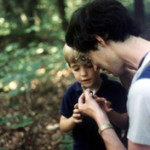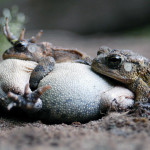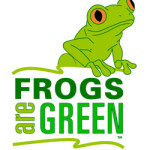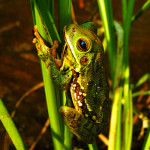We’re excited to announce the 2nd Annual FROGS ARE GREEN Photo contest!
Here are the rules:
This year we will be accepting submissions in two categories: Frogs in the Wild and Backyard Frogs. Backyard Frog photos would include such photos as a frog perched on your picnic table or other unusual place. Last year, for example, we received a photo of a frog sitting on a pool hose. Frogs in the Wild photos, on the other hand, should feature frogs, toads, or other amphibians in their natural habitat: frog ponds, marshes, in the woods, and so on.
PLEASE—no photo manipulation and no photos of pet frogs. Please do not move the frog to get a better photo. Photos of amphibians of all kinds, including salamanders, will be accepted. E-mail all photos to us at Frogs Are Green. All photos should be in jpeg format and no larger than 3 MB. Please name your photo a short but distinctive name, (with no spaces, such as, “susan-frog-NJ.jpg”) and include a caption detailing your name, email and the location of the photo. All entries must be received by September 15, 2010. Winners will be announced October 4, 2010.
PRIZES
Winner:
The winner will receive a Frogs Are Green t-shirt or poster of his/her choice or we can design a special t-shirt and/or poster with your winning photo. The photo will be featured in a separate post and the photo will also appear on the front page of the blog all year.
Honorable mentions:
Honorable mention photos will appear in a gallery on our blog and the photographers will receive our small Red-Eyed Tree Frog poster.
SOME TIPS FOR PHOTOGRAPHING AMPHIBIANS
For those of you who have never photographed an amphibian, here are some tips from the book Frogs: A Chorus of Colors by John and Deborah Behler, which has a chapter on photographing these elusive and well-camouflaged creatures:
• Try to learn about the animal first. What is its habitat? When are they active?
• Walk slowly and stop frequently (it helps to have someone with you who is less than 3 feet tall and has sharp eyes). Frogs and toads blend in so well that they are hard to find. Be alert for subtle movements.
• In summer, you might find the sit-and-wait frog predators hanging out on the edges of ponds and lakes.
• Be aware of the position of the sun. Avoid taking pictures at midday on bright sunny days. In the morning, face east and it will keep sunlight from coming into your lens and washing out your photos.
• Don’t necessarily put the subject in the middle of the photo. Keep the whole animal in the photo, but compose the picture so the background tells a story.
• Bracket your photos, i.e., take the same shot with different settings. Also, try taking a flash photo. Without a flash, animals in photos may look lifeless and poorly lighted.
• Try to be on the same level as your subject.
• State parks, bird sanctuaries, and wildlife refuges are good places to find amphibians.
You don’t need fancy equipment. I took this photo of a bullfrog in low light with a Kodak EasyShare camera on the Flower Setting (close up).
On your travels this summer, keep your eye peeled for our froggy friends and send in your photos!





